2007 FIAT SEDICI weight
[x] Cancel search: weightPage 39 of 266
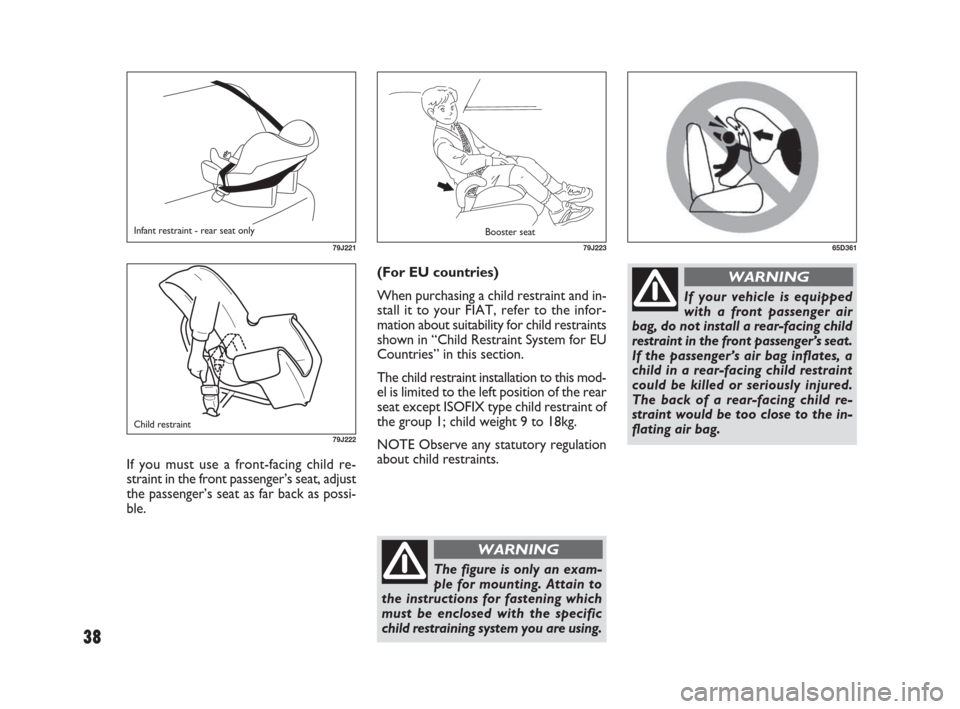
38
(For EU countries)
When purchasing a child restraint and in-
stall it to your FIAT, refer to the infor-
mation about suitability for child restraints
shown in “Child Restraint System for EU
Countries” in this section.
The child restraint installation to this mod-
el is limited to the left position of the rear
seat except ISOFIX type child restraint of
the group 1; child weight 9 to 18kg.
NOTE Observe any statutory regulation
about child restraints.
If you must use a front-facing child re-
straint in the front passenger’s seat, adjust
the passenger’s seat as far back as possi-
ble.
79J221
79J222
79J223
Infant restraint - rear seat only
Child restraintBooster seat
If your vehicle is equipped
with a front passenger air
bag, do not install a rear-facing child
restraint in the front passenger’s seat.
If the passenger’s air bag inflates, a
child in a rear-facing child restraint
could be killed or seriously injured.
The back of a rear-facing child re-
straint would be too close to the in-
flating air bag.
WARNING
65D361
The figure is only an exam-
ple for mounting. Attain to
the instructions for fastening which
must be enclosed with the specific
child restraining system you are using.
WARNING
009-056 Fiat16 New GB 27-11-2007 11:25 Pagina 38
Page 43 of 266

42
INSTALLATION WITH LAP-
SHOULDER SEAT BELTS
(available to the left position of the
rear seat)
IMPORTANT Before installing a child re-
straint system in the rear seat, raise the
head restraint to the most upper position.
ELR type belt
Make sure that the seat belt is securely
latched.
Try to move the child restraint system in
all directions, to make sure it is securely
installed.
Install your child restraint
system according to the in-
structions provided by the child re-
straint system manufacturer.
WARNING
79J224
INSTALLATION WITH ISOFIX
TYPE ANCHORAGES
(available to both left and right
position of the rear seat with the
ISOFIX type of the group 1; child
weight 9 to 18kg)
Your vehicle is equipped with the lower
anchorages in the rear seat outboard seat-
ing positions for securing a ISOFIX type of
child restraints with the connecting bars.
The lower anchorages are located where
the rear of the seat cushion meets the bot-
tom of the seatback.
79J058
Be sure to install the ISOFIX
type of child restraint(s) in
the only outboard seating positions,
not in the central position for rear
seat.
WARNING
If your vehicle is equipped with the top
strap anchorages, be sure to use the top
strap of the child restraint according to
the instructions provided by the child re-
straint system manufacture.
63J020
Install the ISOFIX type child
restraint system according to
the instructions provided by the child
restraint system manufacturer. After
installing, try moving the child re-
straint system in all directions espe-
cially forward, to make sure the con-
necting bars are securely latched to
the anchorages.
WARNING
009-056 Fiat16 New GB 27-11-2007 11:25 Pagina 42
Page 148 of 266
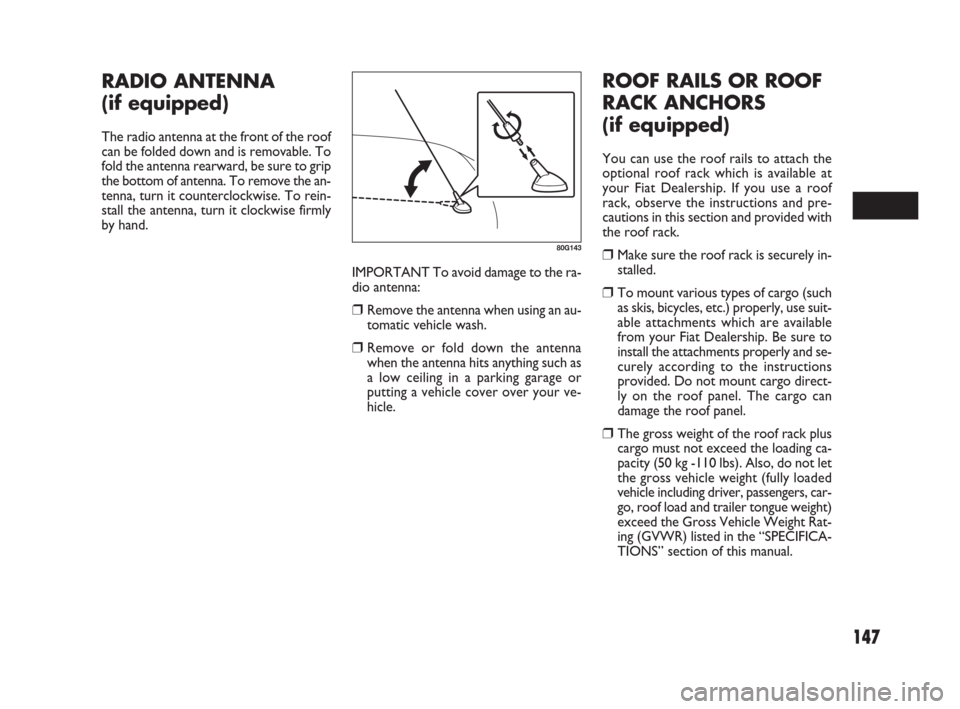
147
IMPORTANT To avoid damage to the ra-
dio antenna:
❒Remove the antenna when using an au-
tomatic vehicle wash.
❒Remove or fold down the antenna
when the antenna hits anything such as
a low ceiling in a parking garage or
putting a vehicle cover over your ve-
hicle.
RADIO ANTENNA
(if equipped)
The radio antenna at the front of the roof
can be folded down and is removable. To
fold the antenna rearward, be sure to grip
the bottom of antenna. To remove the an-
tenna, turn it counterclockwise. To rein-
stall the antenna, turn it clockwise firmly
by hand.
80G143
ROOF RAILS OR ROOF
RACK ANCHORS
(if equipped)
You can use the roof rails to attach the
optional roof rack which is available at
your Fiat Dealership. If you use a roof
rack, observe the instructions and pre-
cautions in this section and provided with
the roof rack.
❒Make sure the roof rack is securely in-
stalled.
❒To mount various types of cargo (such
as skis, bicycles, etc.) properly, use suit-
able attachments which are available
from your Fiat Dealership. Be sure to
install the attachments properly and se-
curely according to the instructions
provided. Do not mount cargo direct-
ly on the roof panel. The cargo can
damage the roof panel.
❒The gross weight of the roof rack plus
cargo must not exceed the loading ca-
pacity (50 kg -110 lbs). Also, do not let
the gross vehicle weight (fully loaded
vehicle including driver, passengers, car-
go, roof load and trailer tongue weight)
exceed the Gross Vehicle Weight Rat-
ing (GVWR) listed in the “SPECIFICA-
TIONS” section of this manual.
129-148 Fiat16 New GB 27-11-2007 11:27 Pagina 147
Page 167 of 266
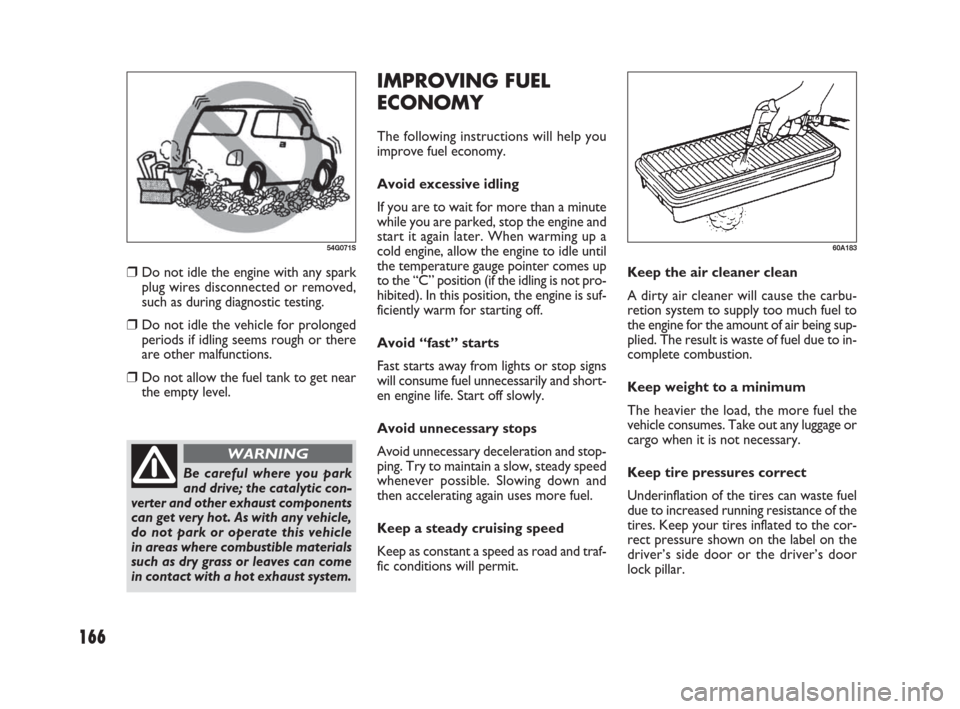
166
IMPROVING FUEL
ECONOMY
The following instructions will help you
improve fuel economy.
Avoid excessive idling
If you are to wait for more than a minute
while you are parked, stop the engine and
start it again later. When warming up a
cold engine, allow the engine to idle until
the temperature gauge pointer comes up
to the “C” position (if the idling is not pro-
hibited). In this position, the engine is suf-
ficiently warm for starting off.
Avoid “fast” starts
Fast starts away from lights or stop signs
will consume fuel unnecessarily and short-
en engine life. Start off slowly.
Avoid unnecessary stops
Avoid unnecessary deceleration and stop-
ping. Try to maintain a slow, steady speed
whenever possible. Slowing down and
then accelerating again uses more fuel.
Keep a steady cruising speed
Keep as constant a speed as road and traf-
fic conditions will permit.Keep the air cleaner clean
A dirty air cleaner will cause the carbu-
retion system to supply too much fuel to
the engine for the amount of air being sup-
plied. The result is waste of fuel due to in-
complete combustion.
Keep weight to a minimum
The heavier the load, the more fuel the
vehicle consumes. Take out any luggage or
cargo when it is not necessary.
Keep tire pressures correct
Underinflation of the tires can waste fuel
due to increased running resistance of the
tires. Keep your tires inflated to the cor-
rect pressure shown on the label on the
driver’s side door or the driver’s door
lock pillar.
60A183
❒Do not idle the engine with any spark
plug wires disconnected or removed,
such as during diagnostic testing.
❒Do not idle the vehicle for prolonged
periods if idling seems rough or there
are other malfunctions.
❒Do not allow the fuel tank to get near
the empty level.
54G071S
Be careful where you park
and drive; the catalytic con-
verter and other exhaust components
can get very hot. As with any vehicle,
do not park or operate this vehicle
in areas where combustible materials
such as dry grass or leaves can come
in contact with a hot exhaust system.
WARNING
149-166 Fiat16 New GB 27-11-2007 11:27 Pagina 166
Page 173 of 266
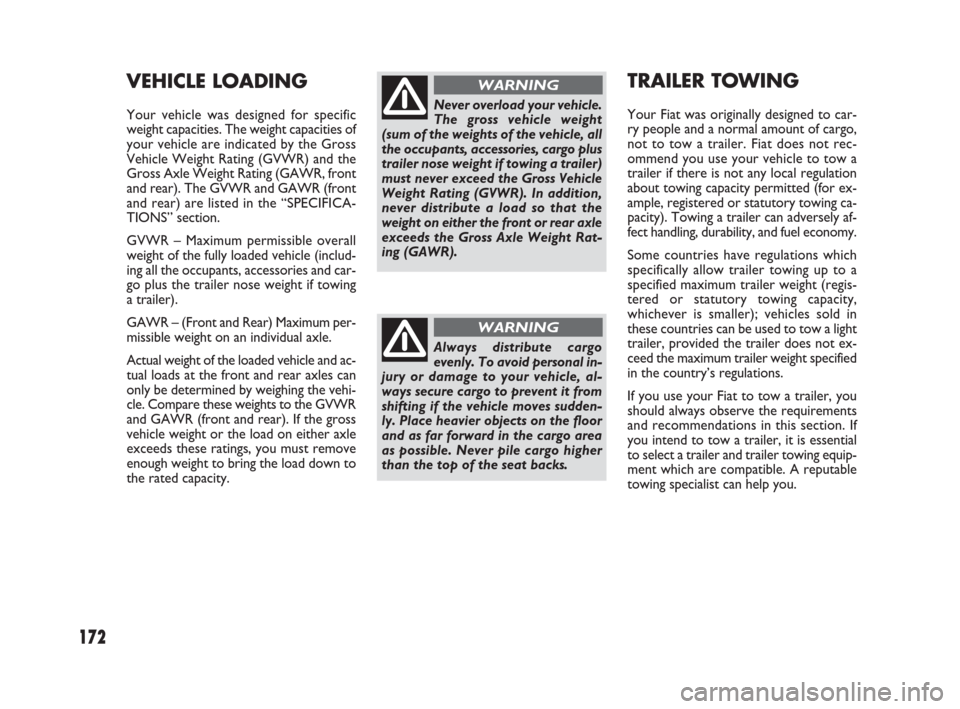
172
TRAILER TOWING
Your Fiat was originally designed to car-
ry people and a normal amount of cargo,
not to tow a trailer. Fiat does not rec-
ommend you use your vehicle to tow a
trailer if there is not any local regulation
about towing capacity permitted (for ex-
ample, registered or statutory towing ca-
pacity). Towing a trailer can adversely af-
fect handling, durability, and fuel economy.
Some countries have regulations which
specifically allow trailer towing up to a
specified maximum trailer weight (regis-
tered or statutory towing capacity,
whichever is smaller); vehicles sold in
these countries can be used to tow a light
trailer, provided the trailer does not ex-
ceed the maximum trailer weight specified
in the country’s regulations.
If you use your Fiat to tow a trailer, you
should always observe the requirements
and recommendations in this section. If
you intend to tow a trailer, it is essential
to select a trailer and trailer towing equip-
ment which are compatible. A reputable
towing specialist can help you.
VEHICLE LOADING
Your vehicle was designed for specific
weight capacities. The weight capacities of
your vehicle are indicated by the Gross
Vehicle Weight Rating (GVWR) and the
Gross Axle Weight Rating (GAWR, front
and rear). The GVWR and GAWR (front
and rear) are listed in the “SPECIFICA-
TIONS” section.
GVWR – Maximum permissible overall
weight of the fully loaded vehicle (includ-
ing all the occupants, accessories and car-
go plus the trailer nose weight if towing
a trailer).
GAWR – (Front and Rear) Maximum per-
missible weight on an individual axle.
Actual weight of the loaded vehicle and ac-
tual loads at the front and rear axles can
only be determined by weighing the vehi-
cle. Compare these weights to the GVWR
and GAWR (front and rear). If the gross
vehicle weight or the load on either axle
exceeds these ratings, you must remove
enough weight to bring the load down to
the rated capacity.Never overload your vehicle.
The gross vehicle weight
(sum of the weights of the vehicle, all
the occupants, accessories, cargo plus
trailer nose weight if towing a trailer)
must never exceed the Gross Vehicle
Weight Rating (GVWR). In addition,
never distribute a load so that the
weight on either the front or rear axle
exceeds the Gross Axle Weight Rat-
ing (GAWR).
WARNING
Always distribute cargo
evenly. To avoid personal in-
jury or damage to your vehicle, al-
ways secure cargo to prevent it from
shifting if the vehicle moves sudden-
ly. Place heavier objects on the floor
and as far forward in the cargo area
as possible. Never pile cargo higher
than the top of the seat backs.
WARNING
171-180 Fiat16 New GB 27-11-2007 11:29 Pagina 172
Page 175 of 266

174
MIRRORS
Check to see if your vehicle’s mirrors
meet local requirements for mirrors used
on towing vehicles. If they do not, you
must install the required mirrors before
you tow.
VEHICLE/TRAILER LOADING
To load your vehicle and trailer proper-
ly, you must know how to measure gross
trailer weight and trailer nose weight.
Gross Trailer Weight is the weight of the
trailer plus all the cargo in it. You can mea-
sure gross trailer weight by putting the ful-
ly loaded trailer on a vehicle scale.
Nose Weight is the downward force ex-
erted on the tow bar by the trailer cou-
pler, with the trailer fully loaded and the
coupler at its normal towing height. This
weight can be measured using a bathroom
scales.
The weight of your loaded trailer (Gross
Trailer Weight) should never exceed the
“Towing capacity”.Distribute cargo in your trailer so that
nose weight is about 10% of gross trailer
weight, but does not exceed “Maximum
vertical load on trailer hitch point”. You
should measure gross trailer weight and
nose weight before towing to make sure
that your load is properly distributed. TIRES
When towing a trailer, it is
very important for your ve-
hicle and trailer to have properly in-
flated tires. Your vehicle’s tires should
be inflated to the pressures listed on
your vehicles Tire Information label.
If laden pressures are listed on the la-
bel, the tires should be inflated to the
laden pressures. Inflate trailer tires
according to the specifications pro-
vided by the trailer manufacturer.
WARNING
Improper weight distribution
of your trailer may result in
poor vehicle handling and swaying of
the trailer. Always make sure that
trailer nose weight is about 10% of
gross trailer weight, but does not ex-
ceed “Maximum vertical load on
trailer hitch point”. Also make sure
that the cargo is properly secured.
Failure to observe this requirement
may result in an accident.
WARNING
171-180 Fiat16 New GB 27-11-2007 11:29 Pagina 174
Page 176 of 266
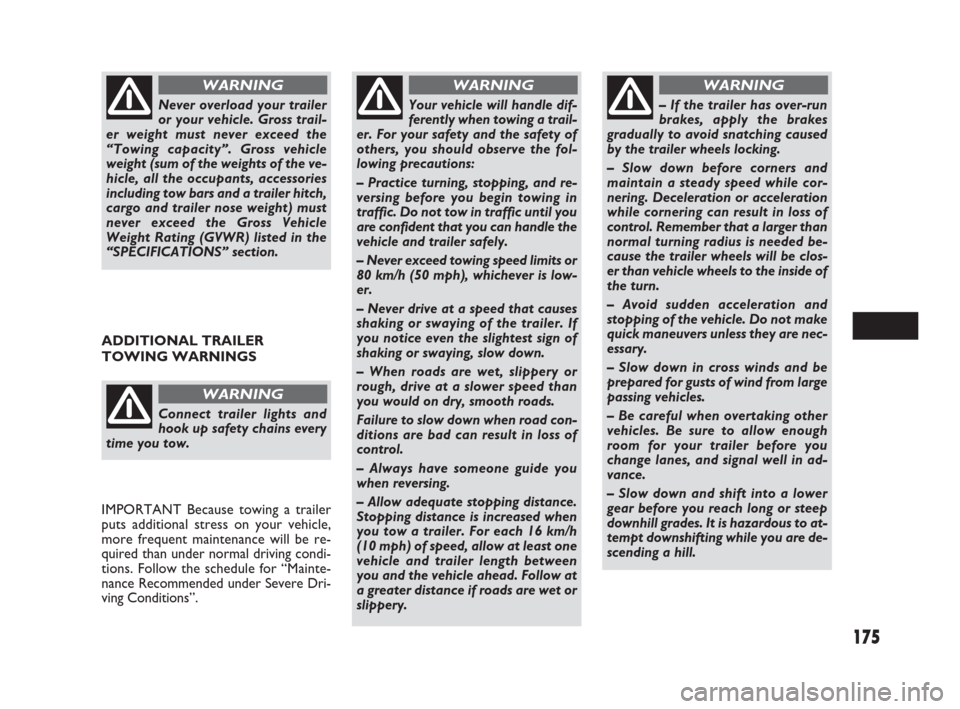
175
ADDITIONAL TRAILER
TOWING WARNINGS
Never overload your trailer
or your vehicle. Gross trail-
er weight must never exceed the
“Towing capacity”. Gross vehicle
weight (sum of the weights of the ve-
hicle, all the occupants, accessories
including tow bars and a trailer hitch,
cargo and trailer nose weight) must
never exceed the Gross Vehicle
Weight Rating (GVWR) listed in the
“SPECIFICATIONS” section.
WARNING
Connect trailer lights and
hook up safety chains every
time you tow.
WARNING
IMPORTANT Because towing a trailer
puts additional stress on your vehicle,
more frequent maintenance will be re-
quired than under normal driving condi-
tions. Follow the schedule for “Mainte-
nance Recommended under Severe Dri-
ving Conditions”.
Your vehicle will handle dif-
ferently when towing a trail-
er. For your safety and the safety of
others, you should observe the fol-
lowing precautions:
– Practice turning, stopping, and re-
versing before you begin towing in
traffic. Do not tow in traffic until you
are confident that you can handle the
vehicle and trailer safely.
– Never exceed towing speed limits or
80 km/h (50 mph), whichever is low-
er.
– Never drive at a speed that causes
shaking or swaying of the trailer. If
you notice even the slightest sign of
shaking or swaying, slow down.
– When roads are wet, slippery or
rough, drive at a slower speed than
you would on dry, smooth roads.
Failure to slow down when road con-
ditions are bad can result in loss of
control.
– Always have someone guide you
when reversing.
– Allow adequate stopping distance.
Stopping distance is increased when
you tow a trailer. For each 16 km/h
(10 mph) of speed, allow at least one
vehicle and trailer length between
you and the vehicle ahead. Follow at
a greater distance if roads are wet or
slippery.
WARNING
– If the trailer has over-run
brakes, apply the brakes
gradually to avoid snatching caused
by the trailer wheels locking.
– Slow down before corners and
maintain a steady speed while cor-
nering. Deceleration or acceleration
while cornering can result in loss of
control. Remember that a larger than
normal turning radius is needed be-
cause the trailer wheels will be clos-
er than vehicle wheels to the inside of
the turn.
– Avoid sudden acceleration and
stopping of the vehicle. Do not make
quick maneuvers unless they are nec-
essary.
– Slow down in cross winds and be
prepared for gusts of wind from large
passing vehicles.
– Be careful when overtaking other
vehicles. Be sure to allow enough
room for your trailer before you
change lanes, and signal well in ad-
vance.
– Slow down and shift into a lower
gear before you reach long or steep
downhill grades. It is hazardous to at-
tempt downshifting while you are de-
scending a hill.
WARNING
171-180 Fiat16 New GB 27-11-2007 11:29 Pagina 175
Page 177 of 266
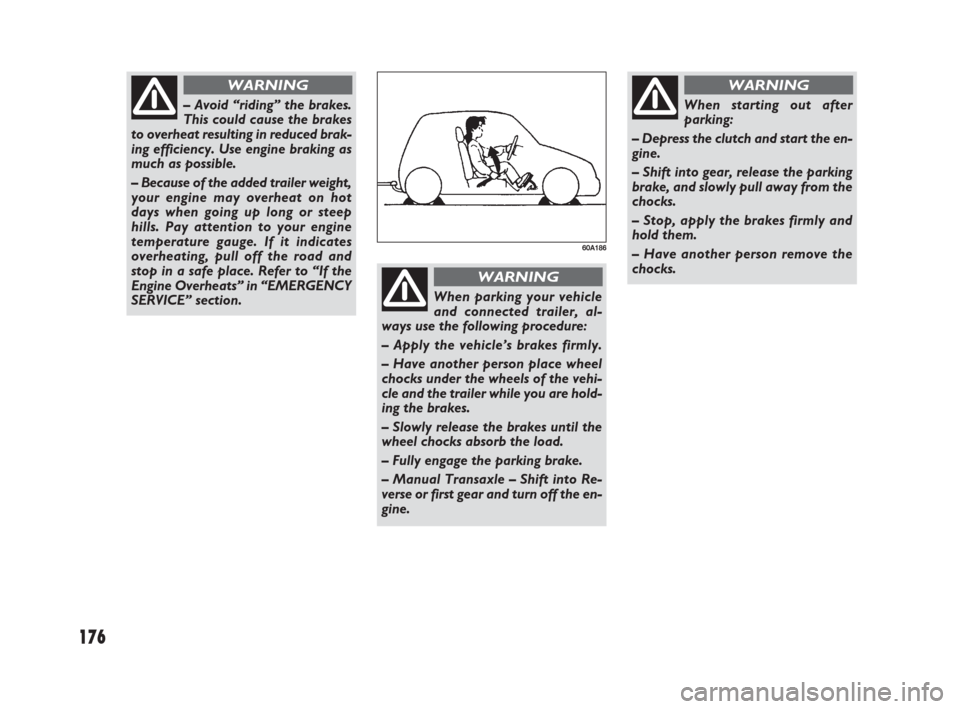
176
– Avoid “riding” the brakes.
This could cause the brakes
to overheat resulting in reduced brak-
ing efficiency. Use engine braking as
much as possible.
– Because of the added trailer weight,
your engine may overheat on hot
days when going up long or steep
hills. Pay attention to your engine
temperature gauge. If it indicates
overheating, pull off the road and
stop in a safe place. Refer to “If the
Engine Overheats” in “EMERGENCY
SERVICE” section.
WARNING
60A186
When parking your vehicle
and connected trailer, al-
ways use the following procedure:
– Apply the vehicle’s brakes firmly.
– Have another person place wheel
chocks under the wheels of the vehi-
cle and the trailer while you are hold-
ing the brakes.
– Slowly release the brakes until the
wheel chocks absorb the load.
– Fully engage the parking brake.
– Manual Transaxle – Shift into Re-
verse or first gear and turn off the en-
gine.
WARNING
When starting out after
parking:
– Depress the clutch and start the en-
gine.
– Shift into gear, release the parking
brake, and slowly pull away from the
chocks.
– Stop, apply the brakes firmly and
hold them.
– Have another person remove the
chocks.
WARNING
171-180 Fiat16 New GB 27-11-2007 11:29 Pagina 176